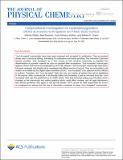| dc.contributor.author | Shetty, Manish | |
| dc.contributor.author | Buesser, Beat | |
| dc.contributor.author | Román-Leshkov, Yuriy | |
| dc.contributor.author | Green, William H | |
| dc.date.accessioned | 2021-10-27T20:10:14Z | |
| dc.date.available | 2021-10-27T20:10:14Z | |
| dc.date.issued | 2017 | |
| dc.identifier.uri | https://hdl.handle.net/1721.1/134999 | |
| dc.description.abstract | © 2017 American Chemical Society. Density functional theory (DFT) calculations were performed on the multistep hydrodeoxygenation (HDO) of acetone (CH3COCH3) to propylene (CH3CHCH2) on a molybdenum oxide (α-MoO3) catalyst following an oxygen vacancy-driven pathway. First, a perfect O-terminated α-MoO3 (010) surface based on a 4 x 2 x 4 supercell is reduced by molecular hydrogen (H2) to generate a terminal oxygen (Ot) defect site. This process occurs via a dissociative chemisorption of H2 on adjacent surface oxygen atoms, followed by an H transfer to form a water molecule (H2O). Next, adsorption of CH3COCH3 on the oxygen-deficient Mo site forms an O-Mo bond and then the chemisorbed CH3COCH3 forms CH3COCH2 by transfer of an H atom to an adjacent Ot site. The surface bound hydroxyl (OH) then transfers the H atom to the immobilized O atom to form surface-bound enol, CH3CHOCH2. The next step releases CH3CHCH2 into the gas phase, while simultaneously oxidizes the surface back to a perfect O-terminated α-MoO3 (010) surface. The adsorption of H2, and the formation of a terminal oxygen (Ot) vacancy, moves the conduction band minimum (CBM) from 1.2 eV to 0 and 0.3 eV, respectively. Climbing image-nudged elastic band (CI-NEB) calculations using a Perdew-Burke-Ernzerhof (PBE) functional in combination with double-ζ valence (DZV) basis sets indicate that the dissociative adsorption of H2 is the rate-limiting step for the catalytic cycle with a barrier of 1.70 eV. Furthermore, the lower barrier for surface-mediated H transfer from primary-to-secondary carbon atom (0.63 eV) compared to that of a concerted direct H transfer to the secondary C atom with simultaneous desorption (2.02 eV) emphasizes the key role played by the surface in H transfer for effective deoxygenation. (Chemical Equation Presented). | |
| dc.language.iso | en | |
| dc.publisher | American Chemical Society (ACS) | |
| dc.relation.isversionof | 10.1021/ACS.JPCC.7B02942 | |
| dc.rights | Article is made available in accordance with the publisher's policy and may be subject to US copyright law. Please refer to the publisher's site for terms of use. | |
| dc.source | Other repository | |
| dc.title | Computational Investigation on Hydrodeoxygenation (HDO) of Acetone to Propylene on α-MoO 3 (010) Surface | |
| dc.type | Article | |
| dc.contributor.department | Massachusetts Institute of Technology. Department of Chemical Engineering | |
| dc.relation.journal | Journal of Physical Chemistry C | |
| dc.eprint.version | Author's final manuscript | |
| dc.type.uri | http://purl.org/eprint/type/JournalArticle | |
| eprint.status | http://purl.org/eprint/status/PeerReviewed | |
| dc.date.updated | 2019-08-19T17:08:49Z | |
| dspace.orderedauthors | Shetty, M; Buesser, B; Román-Leshkov, Y; Green, WH | |
| dspace.date.submission | 2019-08-19T17:08:50Z | |
| mit.journal.volume | 121 | |
| mit.journal.issue | 33 | |
| mit.metadata.status | Authority Work and Publication Information Needed | |
